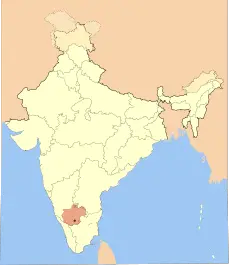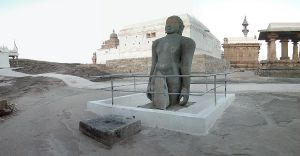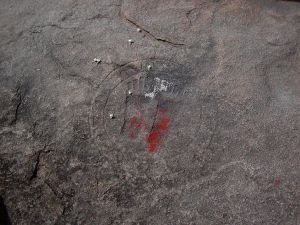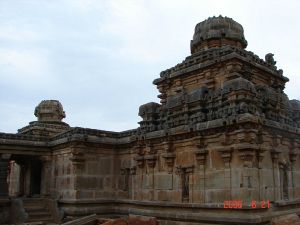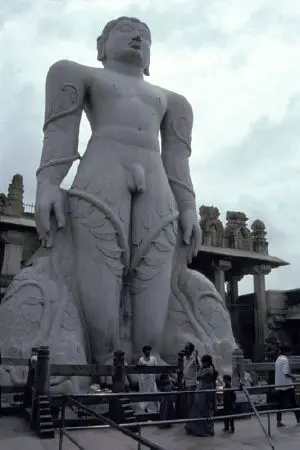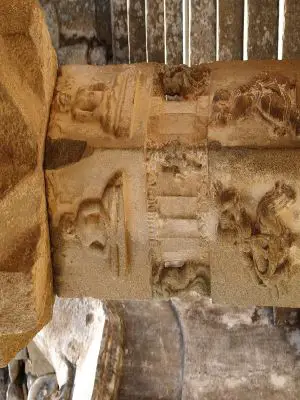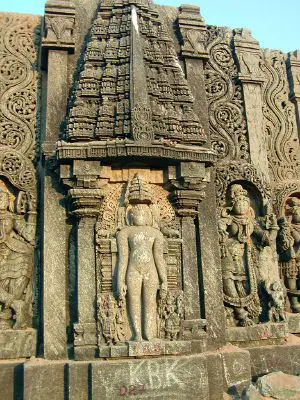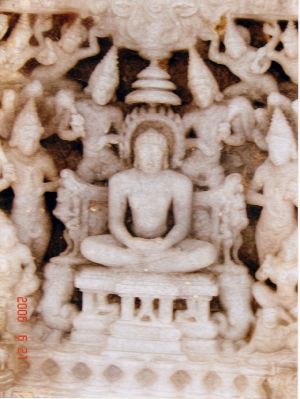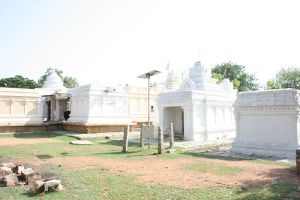Western Ganga Dynasty
| |||||||||||||||||||||||||||||||||
The Western Ganga Dynasty (350 – 1000 C.E.) (Kannada:ಪಶ್ಚಿಮ ಗಂಗ ಸಂಸ್ಥಾನ) - an important ruling dynasty of ancient Karnataka in India, known as Western Gangas to distinguish them from the Eastern Gangas who in later centuries ruled over modern Orissa. The Western Gangas began their rule during a time when multiple native clans asserted their freedom due to the weakening of the Pallava empire in South India, a geo-political event sometimes attributed to the southern conquests of Samudra Gupta. The Western Ganga sovereignty lasted from about 350 to 550 C.E., initially ruling from Kolar and later moving their capital to Talakad on the banks of the Kaveri River in modern Mysore district.
After the rise of the imperial Chalukyas of Badami, the Gangas accepted Chalukya over lordship and fought for the cause of their overlords against the Pallavas of Kanchi. The Rashtrakutas of Manyakheta replaced the Chalukyas in 753 C.E. as the dominant power in the Deccan. After a century of struggle for autonomy, the Western Gangas finally accepted Rashtrakuta over lordship and successfully fought along side them against their foes, the Chola Dynasty of Tanjavur. In the late tenth century, north of Tungabhadra river, the emerging Western Chalukya Empire replaced the Rashtrakutas and the Chola Dynasty saw renewed power south of the Kaveri river. The defeat of the Western Gangas by Cholas around 1000 C.E. resulted in the end of the Ganga influence over the region.
Though territorially a small kingdom, the Western Ganga contribution made an important contribution to polity, culture and literature of the modern south Karnataka region. The Western Ganga kings showed benevolent tolerance to all faiths but most famously for their patronage towards Jainism resulting in the construction of monuments in places such as Shravanabelagola and Kambadahalli. The kings of that dynasty encouraged the fine arts due to which literature in Kannada and Sanskrit flourished. Ninth-century Kannada literature refer to the Ganga King Durvinita of sixth century as an early writer in Kannada language prose. Many classics had been written on various subjects ranging from religion to elephant management.
History
Multiple theories have been proposed regarding the ancestry of the founders of the Western Ganga dynasty (prior to the fourth century).
| Western Ganga Kings (350-999) | |
| Konganivarman Madhava | (350 - 370) |
| Madhava | (370-390) |
| Harivarman | (390-410) |
| Vishnugopa | (410-430) |
| Madhava III Tandangala | (430-469) |
| Avinita | (469 - 529) |
| Durvinita | (529 - 579) |
| Mushkara | (579 - 604) |
| Polavira | (604 - 629) |
| Srivikrama | (629 - 654) |
| Bhuvikarma | (654 - 679) |
| Shivamara I | (679 - 726) |
| Sripurusha | (726 - 788) |
| Shivamara II | (788 - 816) |
| Rachamalla I | (816 - 843) |
| Ereganga Neetimarga | (843 - 870) |
| Rachamalla II | (870 - 907) |
| Ereganga Neetimarga II | (907 - 921) |
| Narasimha | (921 - 933) |
| Rachamalla III | (933 - 938) |
| Butuga II | (938 - 961) |
| Marulaganga Neetimarga | (961 - 963) |
| Marasimha II Satyavakya | (963 - 975) |
| Rachamalla IV Satyavakya | (975 - 986) |
| Rachamalla V (Rakkasaganga) | (986 - 999) |
| Neetimarga Permanadi | (999) |
| Rajaraja Chola I (Chola) |
(985-1014) |
Some mythical accounts point to a northern origin[1] while theories based on epigraphy propose a southern origin. Historians who propose the southern origin have further debated whether the early petty chieftains of the clan (prior to their rise to power) had been natives of the southern districts of modern Karnataka[2], the Kongu region in modern Tamil Nadu [3] or of the southern districts of modern Andhra Pradesh.[4] Those regions encompass an area of the southern Deccan where the three modern states merge geographically. A theory states that the Gangas may have taken advantage of the confusion caused by the invasion of southern India by the northern king Samudra Gupta prior to 350, and carved out a kingdom for themselves. The area they controlled had been called Gangavadi and included regions of the modern districts of Mysore, Chamarajanagar, Tumkur, Kolar, Mandya and Bangalore in Karnataka state. At times, they also controlled some areas in modern Tamil Nadu (Kongu region starting from the sixth century rule of King Avinita) and Andhra Pradesh (Ananthpur region starting from middle of fifth century). Konganivarman Madhava, who made Kolar his capital around 350 and ruled for about 20 years, had been the founding king of the dynasty.
By the time of Harivarman in 390, the Gangas had consolidated their kingdom with Talakad as their capital. Their move from the early capital Kolar may have been a strategic one with the intention of containing the growing Kadamba power. By 430 they had consolidated their eastern territories comprising modern Bangalore, Kolar and Tumkur districts and by 470 they had gained control over Kongu region in modern Tamil Nadu, Sendraka (modern Chikkamagaluru and Belur), Punnata and Pannada regions (comprising modern Heggadadevanakote and Nanjangud) in modern Karnataka.[5] In 529, King Durvinita ascended the throne after waging a war with his younger brother whom his father, King Avinita, favored. Some accounts suggest that in that power struggle, the Pallavas of Kanchi supported Avinita's choice of heir and the Badami Chalukya King Vijayaditya supported his father-in-law, Durvinita.[6] Inscriptions reveal that those battles had been fought in Tondaimandalam and Kongu regions (northern Tamil Nadu) prompting historians to suggest that Durvinita fought the Pallavas successfully.[7] Considered the most successful of the Ganga kings, Durvinita had been well versed in arts such as music, dance, ayurveda and taming wild elephants. Some inscriptions sing paeans to him by comparing him to Yudhishtira and Manu: figures from Hindu mythology known for their wisdom and fairness.[8]
Politically, the Gangas constituted feudatories and close allies who also shared matrimonial relations with the Chalukyas. Inscriptions, which describe their joint campaigns against their arch enemy, the Pallavas of Kanchi, attest to that.[9] From the year 725 onwards, the Gangavadi territories came to be called as the "Gangavadi-96000" (Shannavati Sahasra Vishaya) comprising the eastern and western provinces of modern south Karnataka.[10] King Sripurusha fought the Pallava King Nandivarman Pallavamalla successfully, bringing Penkulikottai in north Arcot under his control temporarily for which he earned the title Permanadi.[11] A contest with the Pandyas of Madurai over control of Kongu region ended in a Ganga defeat, but a matrimony between a Ganga princess and Rajasimha Pandya's son brought peace helping the Gangas retain control over the contested region.[12]
In 753, when the Rashtrakutas replaced the Badami Chalukyas as the dominant force in the Deccan, the Gangas offered stiff resistance for about a century.[13] King Shivamara II won renown for his wars with the Rashtrakuta Dhruva Dharavarsha, his subsequent defeat and imprisonment, his release from prison and eventually his death on the battle field. The Ganga resistance continued through the reign of Rashtrakuta Govinda III and by 819, a Ganga resurgence gained them partial control over Gangavadi under King Rachamalla.[14] Seeing the futility of waging war with the Western Ganga, Rashtrakuta Amoghavarsha I gave his daughter Chandrabbalabbe in marriage to Ganga prince Butuga I, son of King Ereganga Neetimarga. The Gangas thereafter became staunch allies of the Rashtrakutas, a position they maintained till the end of the Rashtrakuta dynasty of Manyakheta.[15]
After an uneventful period, Butuga II ascended the throne in 938 with the help of Rashtrakuta Amoghavarsha III (whose daughter he married). He helped the Rashtrakutas win decisive victories in Tamilakam in the battle of Takkolam against the Chola Dynasty. With that victory, the Rashtrakutas took control of modern northern Tamil Nadu.[16] In return for their valor, the Gangas received extensive territories in the Tungabhadra river valley.[17] King Marasimha II who came to power in 963 aided the Rashtrakutas in victories against the Gurjara Pratihara King Lalla and the Paramara kings of Malwa in Central India.[18] Chavundaraya, a minister in the Western Ganga court had been a valiant commander, able administrator and an accomplished poet in Kannada and Sanskrit. He served King Marasimha II and his successors ably and helped King Rachamalla IV suppress a civil war in 975. Towards the end of the tenth century, the Rashtrakutas had been supplanted by the Western Chalukya Empire in Manyakheta. In the south, the Chola Dynasty, who saw a resurgence of power under Rajaraja Chola I, conquered Gangavadi around the year 1000, bringing the Western Ganga dynasty to an end. Thereafter, large areas of south Karnataka region came under Chola control for about a century.
Administration
Principles stated in the ancient text Arthashastra influenced the Western Ganga administration. The praje gavundas mentioned in the Ganga records held similar responsibilities as the village elders (gramavriddhas) mentioned by Kautilya. Succession to the throne had been hereditary but instances of that being overlooked occurred. The kingdom divided into Rashtra (district) and further into Visaya (consisting of possibly 1000 villages) and Desa. From the eighth century, the Kannada term Nadu replaced the Sanskrit term Visaya. Examples of that change include Sindanadu-8000 and Punnadu-6000,[19] with scholars differing about the significance of the numerical suffix. They opine that represented either the revenue yield of the division computed in cash terms[20] or the number of fighting men in that division or the number of revenue paying hamlets in that division[21] or the number of villages included in that territory.[20]
Inscriptions have revealed several important administrative designations such as prime minister (sarvadhikari), treasurer (shribhandari), foreign minister (sandhivirgrahi) and chief minister (mahapradhana). All of those positions came with an additional title of commander (dandanayaka). Other designations included royal steward (manevergade), master of robes (mahapasayita), commander of elephant corps (gajasahani), commander of cavalry (thuragasahani). In the royal house, Niyogis oversaw palace administration, royal clothing and jewelery and the Padiyara had responsibility for court ceremonies including door keeping and protocol.[22]
Officials at the local level included the pergade, nadabova, nalagamiga, prabhu and gavunda.[23] The pergades had been superintendents from all social classes such as artisans, gold smiths, and black smiths. The pergades dealing with the royal household went by the title manepergade (house superintendent) and those who collected tolls Sunka vergades.[24] The nadabovas, accountants and tax collectors at the Nadu level, sometimes functioned as scribes.[25] The nalagamigas (officers) organized and maintained defense at the Nadu level.[26] The prabhu constituted a group of elite people drawn together to witness land grants and demarcation of land boundaries.[27] The gavundas, appearing most often in inscriptions, served as the backbone of medieval polity of the southern Karnataka region. They acted as landlords and local elite whom the state utilized their services to collect taxes, maintain records of landownership, bear witness to grants and transactions and even raise militia when required.[28]
Inscriptions that specify land grants, rights and ownership described the boundaries of demarcation using natural features such as rivers, streams, water channels, hillocks, large boulders, layout of the village, location of forts (kote) if any in the proximity, irrigation canals, temples, tanks and even shrubs and large trees. Also included, the type of soil, the crops meant to be grown and tanks or wells to be excavated for irrigation.[29] From the Mavali inscription and Indivalli inscription [30] Inscriptions mention wet land, cultivable land, forest and waste land.[31] Numerous references existed to hamlets (palli) belonging to the hunter communities who resided in them (bedapalli).[32] From the sixth century onwards, the inscriptions refer to feudal lords by the title arasa. The arasas had been either brahmins or from tribal background who controlled hereditary territories paying periodic tribute to the king.[33] The velavali,loyal bodyguards of the royalty, had been fierce warriors under oath (vele). They moved with the royal family, expected to fight for the master and be willing to lay down their lives in the process. If the king died, the velavali protocol required self immolation on the funeral pyre of the master.[34]
Economy
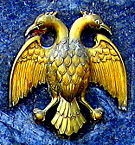 |
The Gangavadi region consisted of the malnad region, the plains (Bayaluseemae) and the semi-malnad with lower elevation and rolling hills. The main crops of the malnad region had been paddy, betel leaves, cardamom and pepper and the semi-malnad region with its lower altitude produced rice, millets such as ragi and corn, pulses, oilseeds and it also served as the base for cattle farming.[35] The plains to the east, constituted flat lands fed by Kaveri, Tungabhadra and Vedavati rivers where cultivations of sugarcane, paddy, coconut, areca nut (adeka totta), betel leaves, plantain and flowers (vara vana) had been common.[36] from the Melkote copper plates and Mamballi inscriptions, Medutambihalli inscription of ninth century [37] Sources of irrigation had been excavated tanks, wells, natural ponds and water bodies in the catchment area of dams (Katta).[38] Inscriptions attesting to irrigation of previously uncultivated lands seem to indicate an expanding agrarian community.[39]
Soil types mentioned in records range from black soil (Karimaniya) in the Sinda-8000 territory and to red soil (Kebbayya mannu)[40] From the Doddahomma inscription of Rachaballa IV of 977 [41] Cultivated land categorized into three types; wet land, dry land and to a lesser extent garden land with paddy being the dominant crop of the region. Wet lands called kalani, galde, nir mannu or nir panya had been specifically used to denote paddy land requiring standing water.[42] Pastoral economies spread throughout Gangavadi region, as evidenced from references to cowherds in many inscriptions. The terms gosahasra (a thousand cows), gasara (owner of cows), gosasi (donor of cows), goyiti (cowherdess), gosasa (protector of cows) attest to that.[43] Inscriptions indicate ownership of cows may have been as important as cultivable land and a social hierarchy based on that may have existed.[44] Inscriptions mention cattle raids attesting to the importance of the pastoral economy, destructive raids, assaults on women (pendir-udeyulcal), abduction of women by bedas (hunter tribes); all of which indicate the existing militarism of the age.[45]
Some lands enjoyed exemption from taxes (manya), sometimes consisted of several villages. Local chieftains granted them without any reference to the overlord, indicating a de-centralized economy. Those lands (bilavritti or kalnad) often had been given to heroes who perished in the line of duty.[46] Such a grant made for the maintenance of temples at the time of consecration had been called Talavritti.[47] Some types of taxes on income were kara or anthakara (internal taxes), utkota (gifts due to the king), hiranya (cash payments) and sulika (tolls and duties on imported items). Taxes had been collected from those who held the right to cultivate land; even if the land lay uncultivated.[48][49]
Siddhaya referred to a local tax levied on agriculture and pottondi to a tax levied on merchandise by the local feudal ruler. Based on context, pottondi also meant 1/10, aydalavi meant 1/5 and elalavi meant 1/7.[50] Mannadare literally meant land tax, levied together with shepherds tax (Kurimbadere) payable to the chief of shepherds. Bhaga meant a portion or share of the produce from land or the land area itself. Minor taxes such as Kirudere (due to the landlords) and samathadere (raised by the army officers or samantha) had been mentioned. In addition to taxes for maintenance of the local officer's retinue, villages had an obligation to feed armies on the march to and from battles.[51] Bittuvatta or niravari taxes comprised usually of a percentage of the produce collected for constructing irrigation tanks.[52]
Culture
Religion
The Western Gangas gave patronage to all the major religions of the time; Jainism and the Hindu sects of Shaivism, Vedic Brahminism and Vaishnavism. Scholars have argued that some Gangas kings may have been prejudiced. Some historians believe that the Gangas had been ardent Jains.[53] Inscriptions contradict that by providing references to kalamukhas (staunch Shaiva ascetics), pasupatas and lokayatas (followers of Pasupatha doctrine) who flourished in Gangavadi, indicating that Shaivism had been also popular. King Madhava and Harivarman had been devoted to cows and brahmins, King Vishnugopa practiced as a devout Vaishnava, Madhava III's and Avinita's inscriptions describe lavish endowments to Jain orders and temples[54] and King Durvinita performed Vedic sacrifices prompting historians to claim he had been a Hindu.[55]
Jainism became popular in the dynasty in the eighth century when the ruler King Shivamara I constructed numerous Jain basadis.[56] King Butuga II and minister Chavundaraya had been staunch Jains, evidenced by the construction of the Gomateshwara monolith.[57] Jains worshipped the 24 tirthankars (Jinas) whose images had been consecrated in their temples. They believed that the tirthankars had creative and destructive powers, similar to the beliefs of Hindus who assigned those powers to the holy trinity (Trimurti); Brahma, Vishnu and Shiva.[58] The worship of the footprint of spiritual leaders such as those of Bhadrabahu in Shravanabelagola from the tenth century parallels Buddhism.[59] The consecration of the Gomateshwara monolith, the statue of Bahubali, the son of tirthankar Adinatha (just as Hindus worshipped the sons of Shiva) displays some brahminical influences.[60] The worship of subordinate deities such as yaksa and yaksi, earlier considered as mere attendants of the tirthankars had been seen from the seventh century to the twelfth century.[61]
Vedic Brahminism proved popular in the sixth and seventh centuries when inscriptions refer to grants made to Srotriya Brahmins.[62] Those inscriptions also describe the gotra (lineage) affiliation to royal families and their adherence of such Vedic rituals as asvamedha (horse sacrifice) and hiranyagarbha.[63] Brahmins and kings enjoyed a mutually beneficial relationship; rituals performed by the brahmins gave legitimacy to kings and the land grants made by kings to brahmins elevated them in society to the level of wealthy landowners.[64] Vaishnavism maintained a low profile, few inscriptions describe grants towards its cause.[65] Some Vaishnava temples were built by the Gangas such as the Narayanaswami temples at Nanjangud, Sattur and Hangala in modern Mysore district.[66] The deity Vishnu has been depicted with four arms holding a conch (sanka), discus (cakra), mace (gada) and lotus (padma).[67]
From the beginning of the eighth century, patronage to Shaivism increased in every section of the society; the landed elite, landlords, assemblies (samaya), schools of learning (aghraharas)[68] and minor ruling families such as the Bana, Nolamba and Chalukya clans. The Shaiva temples contained a Shiva linga (phallus) in the sanctum sanctorum along with images of the mother goddess, Surya (Sun god)[69] and Nandi (a bull and attendant of Shiva) normally enshrined in a separate pavilion facing the sanctum.[70] The linga had been man made and in some cases had etchings of Ganapati (son of Shiva) and Parvati (consort and wife of Shiva) on it.[70] Due to the vigorous efforts of priests and ascetics, Shaiva monastic orders flourished in many places such as Nandi Hills, Avani and Hebbata in modern Kolar district.[71]
Society
The Western Ganga society in many ways reflected the emerging religious, political and cultural developments of those times. Women became active in local administration because Ganga kings distributed territorial responsibility to their queens such as the feudal queen Parabbaya-arasi of Kundattur[72] and the queens of King Sripurusha, Butuga II and feudal king Permadi.[73] The son-in-law, the wife or by the daughter evidentially inherited fiscal and administrative responsibility. The position of prime minister of King Ereganga II and position of nalgavunda (local landlord) bestowed upon Jakkiabbe, the wife of a fallen hero offer examples. When Jakkiabbe took to asceticism, her daughter inherited the position.[74][75]
The devadasi system (sule or courtesan) in temples prevailed, modeled after the structures in the royal palace.[76] Contemporaneous literature such a Vaddaradhane makes a mention of the chief queen (Dharani Mahadevi) accompanied by lower ranking queens (arasiyargal) and courtesans of the women's royal quarter (pendarasada suleyargal).[77] Some of the courtesans and concubines employed in the harem of the kings and chieftains attained respect, examples being Nandavva at whose instance a local chief made land grant to a Jain temple.[78] Education in the royal family had been closely supervised and included such subjects as political science, elephant and horse riding, archery, medicine, poetry, grammar, drama, literature, dance, singing and use of musical instruments.[73] Brahmins enjoyed an influential position in society, enjoying exemption from certain taxes and customs due on land. In turn they managed public affairs such as teaching, local judiciary, functioned as trustees and bankers, managed schools, temples, irrigation tanks, rest houses, collected taxes due from villages and raised money from public subscriptions.[79]
By virtue of a Hindu belief that killing of a brahmin (Bramhatya) constituted a sin, they escaped capital punishment.[80] Upper caste kshatriyas (satkshatriya) also had been exempt from capital punishment due to their higher position in the caste system. Severe crimes committed had been punishable by the severing of a foot or hand.[81] Contemporary literary sources reveal up to ten castes in the Hindu caste system; three among kshatriya, three among brahmin, two among vaishya and two among shudras.[82] Family laws permitted a wife or daughter or surviving relatives of a deceased person to claim properties such as his home, land, grain, or money if no male heirs existed. If no claimants to the property stepped forward, the state took possession of those properties as Dharmadeya (charitable asset). [83] Intercaste marriage, child marriage, marriage of a boy to maternal uncle’s daughter, Svayamvara marriage (where the bride garlands her choice of a groom from among many aspirants) had been in vogue.[84] Memorials containing hero stones (virkal) had been erected for fallen heroes and the concerned family received monetary aid for maintenance of the memorial.[85]
The presence of numerous Mahasatikals (or Mastikal—hero stones for a woman who accepted ritual death upon the demise of her husband) indicates the popularity of Sati among royalty.[86] Ritual death by sallekhana and by jalasamadhi (drowning in water) had been also practiced.[87] Popular clothing among men consisted of two unrestricted garments, a Dhoti as a lower garment and a plain cloth as upper garment while women wore Saris with stitched petticoats. Turbans had been popular with men of higher standing and people used umbrellas made with bamboo or reeds.[88] Men and women enjoyed wearing ornaments; they decorated elephants and horses. Men wore finger rings, necklaces (honnasara and honnagala sara), bracelets (Kaduga) and wristlets (Kaftkina). Women wore a nose jewel (bottu), nose ring (mugutti), bangles (bale or kankana) and various types of necklaces (honna gante sara and kati sutra).[88] During leisure, men amused themselves with horse riding, watching wrestling bouts, cock fights and ram fights.[89] There existed a large and well organized network of schools for imparting higher education and these schools were known by various names such as agraharas, ghatikas, brahmapura or matha.[90] Inscriptions mention schools of higher education at Salotgi, Balligavi, Talagunda, Aihole, Arasikere and other places.
Literature
The Western Ganga rule had been a period of brisk literary activity in Sanskrit and Kannada, though many of the writings have been lost and known only by references made to them. Chavundaraya's writing, Chavundaraya Purana (or Trishashtilakshana mahapurana) of 978 C.E., an early existing work in prose style in Kannada, contains a summary of the Sanskrit writings, Adipurana and Uttarapurana written a century earlier by Jinasena and Gunabhadra during the rule of Rashtrakuta Amoghavarsha I. The prose, composed in lucid Kannada, had been mainly meant for the common man and avoided any reference to complicated elements of Jain doctrines and philosophy. His writings may have been influenced by the writings of his predecessor Adikavi Pampa and contemporary Ranna. The work narrates the legends of a total of 63 Jain proponents including 24 Jain Tirthankars, 12 Chakravartis, nine Balabhadras , nine Narayanas and nine Pratinarayanas.[91]
King Durvinita of the sixth century stands as the earliest known Kannada writer from that dynasty. Kavirajamarga of 850 C.E., refers to him as an early writer of Kannada prose.[92] Around 900 C.E., Gunavarma I authored the Kannada works, Sudraka and Harivamsa. His writings, now extinct, have been referred to in later years. King Ereganga Neetimarga II patronized him. In Sudraka, he has favorably compared his patron to King Sudraka of ancient times.[93] Chavundaraya patronized the great Kannada poet Ranna in his early literary days. Ranna's classic Parashurama charite represents a eulogy of his patron who held such titles as Samara Parashurama.
Chavundaraya also patronized Nagavarma I, a brahmin scholar who came from Vengi in modern Andhra Pradesh (late tenth century). He wrote Chandombudhi (ocean of prosody) addressed to his wife, considered the earliest available Kannada writing in prosody.[94] He also wrote one of the earliest available romance classics in Kannada called Karnataka Kadambari in sweet and flowing champu (mixed verse and prose) style. Based on an earlier romantic work in Sanskrit by poet Bana, the work became popular among critics.[94] King Shivamara II wrote Gajashtaka (100 verses on elephants), a rare Kannada work on elephant management, around 800 C.E. but that work has become extinct. Other writers such as Manasiga and Chandrabhatta enjoyed popularity in the tenth century.[95]
In an age of classical Sanskrit literature, Madhava II (brother of King Vishnugopa) wrote a treatise Dattaka Sutravritti based on an earlier work on erotics by a writer called Dattaka. A Sanskrit version of Vaddakatha, a commentary on Panini's grammar called Sabdavathara and a commentary on the fifteenth chapter of a Sanskrit work called Kiratarjunneya by poet Bharavi (who worked in Durvinita's court) have been ascribed to Durvinita. King Shivamara II wrote Gajamata Kalpana. Hemasena's pupil wrote Vadeebhasimha Gayachintamani and Kshatrachudamini, based on poet Bana's work Kadambari, in prose style. and Chavundaraya wrote Charitarasara.
Architecture
The Pallava and Badami Chalukya architectural features, in addition to with indigenous Jain features, influenced the Western Ganga style of architecture. The Ganga pillars with a conventional lion at the base and a circular shaft of the pillar on its head, the stepped Vimana of the shrine with horizontal mouldings and square pillars had been features inherited from the Pallavas. Those features exist in structures built by their subordinates, the Banas and Nolambas.
The monolith of Gomateshwara commissioned by Chavundaraya constitutes the high point of the Ganga sculptural contribution in ancient Karnataka. Carved from fine-grained white granite, the image stands on a lotus. Lacking support up to the thighs, standing 60 feet tall with the face measuring 6.5 feet. With the serene expression on the face of the image, its curled hair with graceful locks, its proportional anatomy, the monolith size, and the combination of its artistry and craftsmanship have been declared the mightiest achievement in sculptural art in medieval Karnataka. It is the largest monolithic statue in the world.[96] Their free standing pillars, called Mahasthambha or Bhrahmasthambha, also considered unique, provide examples of the Brahmadeva pillar and Tyaga Brahma pillars. At the top of the pillar, the shaft (cylindrical or octagonal) decorated with creepers and other floral motifs, sits the Brahma and the base of the pillar normally has engravings of important Jain personalities and inscriptions.
Other important contributions include the Jain basadis' whose towers have gradually receding stories (talas) ornamented with small models of temples. Those tiny shrines have in them engravings of tirthankars (Jain saints). Semicircular windows connect the shrines and decorative Kirthimukha (demon faces) ornament the top. The Chavundaraya basadi built in the tenth or eleventh century, Chandragupta basadi built in the sixth century and the monolithic of Gomateshwara of 982 represent the most important monuments at Shravanabelagola. The famous Hoysala sculptor Dasoja added some features to the Chandragupta basadi in the twelfth century. The decorative door jambs and perforated screen windows depict scenes from the life of King Chandragupta Maurya, which he created.[97] The Panchakuta basadi ( five towered temple) at Kambadahalli of 900 with a Brahmadeva pillar provides an excellent example of Dravidian art.[98] Torana (lintel) with carvings of floral motifs, flying divine creatures (gandharva) and imaginary monsters (makara) ridden by Yaksas (attendants of saints) surmount the wall niches while images of tirthankars themselves occupy the niches.[99]
The Gangas build many Hindu temples with impressive Dravidian gopuras containing stucco figures from the Hindu pantheon, decorated pierced screen windows featured in the mantapa (hall) along with saptamatrika carvings (seven heavenly mothers). Some well known examples include the Kapileswara temple at Manne, Kolaramma temple at Kolar and the Kallesvara temple at Aralaguppe. At Talakad they built the Maralesvara temple, the Arakesvara temple and the Patalesvara temple. Unlike the Jain temples, with floral frieze decoration common, friezes (slab of stone with decorative sculptures) illustrating episodes from the epics and puranas distinguish Hindu temples.[99] The number of virgal (hero stones) they have left behind represents another unique legacy of the Gangas; memorials containing sculptural details of war scenes, Hindu deities, saptamatrikas and Jain tirthankars.
Language
The Western Gangas used Kannada and Sanskrit extensively as their language of administration. Some of their inscriptions had been written bilingual in these languages. In bilingual inscriptions the formulaic passages stating origin myths, genealogies, titles of Kings and benedictions tended to be in Sanskrit, while the actual terms of the grant such as information on the land or village granted, its boundaries, participation of local authorities, rights and obligations of the grantee, taxes and dues and other local concerns appeared in the local language. [100] The usage of those two languages showed important changes over the centuries. During the first phase (350-725), Sanskrit copper plates dominated, indicating the initial ascendancy of the local language as a language of administration and that the majority of records from that phase had been Brahmadeya grants (grants to Brahmin temples).[101] In the second phase (725-1000), lithic inscriptions in Kannada outnumbered Sanskrit copper plates, consistent with the patronage Kannada received from rich and literate Jains who used Kannada as their medium to spread the Jain faith.[102] Recent excavations at Tumbula near Mysore have revealed a set of early copper plate bilingual inscriptions dated 444. The genealogy of the kings of the dynasty appears in Sanskrit while the description of the boundary of the village had been written in Kannada.[103] The epigraph dated 890 that refers to a Bengaluru war, an interesting inscription discovered at Beguru near modern Bangalore, deserves mention. Written in Hale Kannada (old Kannada) language, the inscription represents the earliest mention of the name of Bangalore city.[104] The Western Gangas minted coins with Kannada and Nagari legends, [105] the most common feature on their coins had been the image of an elephant on the obverse and floral petal symbols on the reverse. The Kannada legend Bhadr, a royal umbrella or a conch shell, appeared on top of the elephant image. The denominations include the pagoda (weighing 52 grains), the fanam weighting one-tenth or one-half of the pagoda and the quarter fanams.
See also
- Rashtrakuta Dynasty
- Kadamba Dynasty
- Western Chalukya Empire
- Chalukya dynasty
- Chola Dynasty
- Political history of medieval Karnataka
- Karnataka
Notes
- ↑ Jayaswal in Arthikaje,Mangalore. Gangas of Talkad. 1998-2000 OurKarnataka.Com, Inc. Retrieved February 11, 2009.
- ↑ Ramesh 1984, 1-2
- ↑ Robert Sewell and Vishwanatha in Arthikaje,Mangalore. Gangas of Talkad. 1998-2000 OurKarnataka.Com, Inc. Retrieved February 11, 2009.
- ↑ Krishna Rao in Adiga 2006, 88
- ↑ From the Cakra-Kedara grant, Kodunjeruvu grant (Adiga 2006, 99)
- ↑ Sheik Ali and Ramesh in Adiga 2006, 100-101
- ↑ Adiga 2006, 101
- ↑ Adiga 2006, 109
- ↑ From the Aihole inscriptions and the Jangamarahalli inscription (Adiga 2006, 102)
- ↑ (Adiga 2006, 103)
- ↑ A later Ganga King Rachamalla I (Ramesh in Adiga, 115) received the title, the Agali grant and Devarahalli inscription calls Sripurusha Maharajadhiraja Paramamahesvara Bhatara (Adiga 2006, 15-116)
- ↑ From Salem plates of Sripurusha dated 771 and the Koramangala grant(Ramesh in Adiga 2006, 116)
- ↑ From several Tumkur inscriptions (Adiga 2006, 117)
- ↑ Adiga 2006, 118
- ↑ from the Konnur inscriptions of 860 and Rajaramadu inscription (Adiga 2006, 119)
- ↑ Tirukkalukkunram and Laksmeshwar inscriptions - Krishna III, an incarnation of death for the Chola Dynasty, annexed Kanchi and Tanjore (Reu 1933, 83)
- ↑ From the Kudlur inscription of King Marasimha II (Adiga 2006, 120)
- ↑ From the Kukkanur inscription (Adiga 2006, p. 122)
- ↑ Adiga 2006, 10
- ↑ 20.0 20.1 Rice in Adiga 2006, 15
- ↑ Sharma in Adiga 2006, 16
- ↑ Adiga (2006), p. 238
- ↑ Adiga 2006, 161-177
- ↑ From the Kanatur inscription (Adiga 2006, 161)
- ↑ From the Kanatur inscription (Adiga 2006, 164)
- ↑ From the Mavali inscription of 8th century and Indravalli inscription (Adiga 2006, 165)
- ↑ Doddakunce inscription, the Karagada and Maruru inscription (Adiga 2006, 167-68)
- ↑ Bedirur inscriptions of 635 (Adiga 2006, 168)
- ↑ From the Kumsi inscription of 931 and Doddahomma inscription of 977 (Adiga 2006, 21-22, 27, 29)
- ↑ (Adiga 2006, 31)
- ↑ From the Devarahalli and Hosur copper plates (Adiga 2006, 33)
- ↑ From inscriptions and literary writings such as Vaddaradhane (920) and Pampa Bharata (940) (Adiga 2006, 36-37)
- ↑ Adiga 2006, 208
- ↑ Adiga 2006, 233-234
- ↑ Adiga 2006, 6
- ↑ Adiga 2006, 10
- ↑ (Adiga 2006, 53)
- ↑ Adiga 2006, 42
- ↑ Adiga 2006, 45
- ↑ from the Narasimhapura plates (Adiga 2006, 46)
- ↑ (Adiga 2006, 47)
- ↑ Kittel in Adiga 2006, 48
- ↑ Belagi inscription of 964, Sasarvalli inscription of 1001 (Krishna and Adiga 2006, 55-56)
- ↑ Adiga 2006, 57
- ↑ From the Kodagu inscription of 11th century, Guduve inscription of 1032, Kambadahalli inscription of 979 (Adiga 2006, 59, 60, 63)
- ↑ From the Narasimhapura inscription of ninth century (Sircar and Ramesh in Adiga 2006, 210-211)
- ↑ Indian epigraphical glossary, Hecca inscription p. 939 for SriKanteshvara temple (Adiga 2006, 213)
- ↑ From Nonamangala copper plates of fifth century of King Avinita (Adiga 2006, 216)
- ↑ From the Kuppepalya inscription of eighth century (Adiga 2006, 218)
- ↑ Kotutu inscription of ninth century, Rampura inscription of 905 (Adiga 2006, 219)
- ↑ Varuna inscription, (Adiga 2006, 223-224)
- ↑ Adiga 2006, 230
- ↑ Dr. Lewis Rice, S. R. Sharma and M. V. Krishna Rao Arthikaje, Mangalore. History of Karnataka-Gangas of Talkad. 1998-2000 OurKarnataka.Com, Inc. Retrieved February 12, 2009.
- ↑ Adiga 2006, 249
- ↑ Srikanta Sastri in Arthikaje, Mangalore. History of Karnataka-Gangas of Talkad. 1998-2000 OurKarnataka.Com, Inc. Retrieved February 12, 2009.
- ↑ From the Kulaganga and Narasimhapura copper plates (Adiga 2006, 255)
- ↑ From the Kudlur plates of Butuga II (Adiga 2006, 256)
- ↑ Adiga 2006, 262
- ↑ P.B.Desai and Jaiswal in Adiga 2006, 263-264
- ↑ Adiga 2006, 264
- ↑ Adiga 2006, 264-265
- ↑ Adiga 2006, 253
- ↑ From the Bendiganhalli and Bangalore copper plates, the Chaluvanahalli plates, Kutalur grant, Kadagattur and Nallala grants of King Durvinita, Kondunjeruvu grant of King Avinita (Adiga 2006, 281-282)
- ↑ Adiga 2006, 282
- ↑ Adiga 2006, 313
- ↑ From the Kalkunda inscription (Adiga 2006, 314-316)
- ↑ Adiga 2006, 317
- ↑ Adiga 2006, 291
- ↑ This was popularized by the kalamukha monks (Adiga 2006, 292)
- ↑ 70.0 70.1 Adiga 2006, 301
- ↑ From Nandi copper plates of 800, Avani pillar inscription, Perbetta hero stones, 878 inscription of Nolamba Mahendradhiraja, Baragur inscription of 919, 942 Tumkur grant and Basavanahalli inscriptions (Adiga 2006, 304-305)
- ↑ From the Kuntur inscription of tenth century (Adiga 2006, 203)
- ↑ 73.0 73.1 Karmarkar 1947, 66
- ↑ from the Bandalike inscription of 919 (Adiga 2006, 203)
- ↑ From the Shravanabelagola inscription (Adiga 2006, 204)
- ↑ Adiga 2006, 398
- ↑ Adiga 2006, 398
- ↑ From the Perur plates (Adiga 2006, 398)
- ↑ Karmarkar 1947, 72, 74
- ↑ Altekar 1934, 329
- ↑ From the notes of Alberuni and Bouchet (Karmarkar 1947, 103)
- ↑ From the notes of Yuan Chwang (Karmarkar 1947, 103)
- ↑ From a modern Bijapur inscription of 1178 (Karmarkar, 1947, 104)
- ↑ The Svayamvara marriage of Chalukya King Vikramaditya VI to Chandaladevi in the 11th century being an example (Karmarkar 1947, 105)
- ↑ Karmarkar 1947, 109
- ↑ From the writings of Marco Polo, Ibn Batuta, Bernier and Tavernier (Karmarkar 1947, 110)
- ↑ Karmarkar 1947, 110
- ↑ 88.0 88.1 Karmarkar 1947, 111
- ↑ Karmarkar 1947, 112
- ↑ Karmarkar 1947, 113
- ↑ Kulkarni (1975) in Adiga 2006, 256
- ↑ Narasimhacharya 1988, 2
- ↑ Narasimhacharya 1988, 18
- ↑ 94.0 94.1 Narasimhacharya 1988, 18
- ↑ Narasimhacharya 1988, 19
- ↑ Keay, John (2000). India: A History. New York: Grove Press, 324 (across). ISBN 0802137970.
- ↑ Adiga 2006, 269
- ↑ Error on call to template:cite web: Parameters url and title must be specifiedKhajane, Muralidhara. .
- ↑ 99.0 99.1 Adiga 2006, 268
- ↑ Thapar 2003, 393-394
- ↑ Adiga 2006, 110
- ↑ Thapar 2003, 396
- ↑ N. Havalaiah. Ancient inscriptions unearthed. The Hindu, Saturday, January 24, 2004. The Hindu. Retrieved February 11, 2009.
- ↑ Staff Reporter. Inscription reveals Bangalore is over 1,000 years old. The Hindu, Friday, August 20, 2004. The Hindu. Retrieved February 11, 2009.
- ↑ Error on call to template:cite web: Parameters url and title must be specified. Govindraya Prabhu S, November 1, 2001.
ReferencesISBN links support NWE through referral fees
|
|
External Links
All links retrieved May 4, 2023.
| ||||||||||||||||||||||||||
Credits
New World Encyclopedia writers and editors rewrote and completed the Wikipedia article in accordance with New World Encyclopedia standards. This article abides by terms of the Creative Commons CC-by-sa 3.0 License (CC-by-sa), which may be used and disseminated with proper attribution. Credit is due under the terms of this license that can reference both the New World Encyclopedia contributors and the selfless volunteer contributors of the Wikimedia Foundation. To cite this article click here for a list of acceptable citing formats.The history of earlier contributions by wikipedians is accessible to researchers here:
The history of this article since it was imported to New World Encyclopedia:
Note: Some restrictions may apply to use of individual images which are separately licensed.
